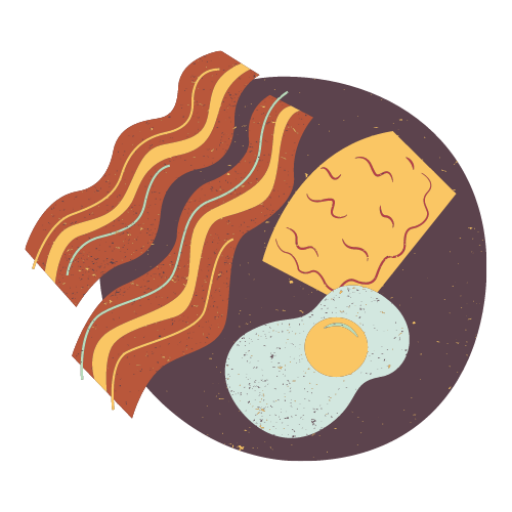Starting your day with a low-sodium breakfast can set a positive tone for your overall health. Many traditional breakfast foods are high in sodium, which can contribute to health issues like hypertension. Fortunately, there are numerous delicious options that naturally contain little to no salt.
By choosing low-sodium breakfast recipes, you can support heart health while still enjoying flavorful and satisfying meals. These recipes often utilize fresh ingredients such as fruits, vegetables, whole grains, and lean proteins to create tasty and nutritious breakfasts. From sweet to savory options, there’s a wide variety of low-sodium breakfast ideas to explore that can fit easily into a health-conscious diet.
1) Avocado Toast with Tomato
Avocado toast with tomato is a simple yet nutritious low-sodium breakfast option. This dish combines creamy avocado with juicy tomatoes atop toasted whole-grain bread.
To prepare, start by mashing ripe avocado in a bowl. Add a squeeze of fresh lemon juice for flavor and to prevent browning. Spread the mashed avocado on toasted bread.
Top the avocado with sliced tomatoes for added texture and taste. For extra flavor without sodium, sprinkle herbs like basil or oregano over the tomatoes.
This breakfast provides healthy fats from avocados and fiber from whole-grain bread. The tomatoes contribute vitamins and antioxidants. By omitting salt, this dish remains naturally low in sodium.
For variety, try different types of tomatoes such as cherry or heirloom. Experiment with various whole-grain breads like sourdough or rye for different textures and flavors.
2) Greek Yogurt Parfait

Greek yogurt parfaits offer a nutritious, low-sodium breakfast option that’s both delicious and easy to prepare. These layered creations combine protein-rich Greek yogurt with fresh fruits and crunchy granola.
To make a parfait, start with a base of plain, unsweetened Greek yogurt. This provides a creamy texture and substantial protein without added sodium. Layer the yogurt with a variety of fresh fruits like berries, sliced peaches, or diced melon.
For added crunch and fiber, sprinkle in some low-sodium granola or chopped nuts. These elements contribute healthy fats and complex carbohydrates to the meal. Avoid store-bought granolas, which often contain added salt, and opt for homemade versions instead.
For natural sweetness, drizzle a small amount of honey or maple syrup over the layers. Alternatively, use mashed ripe banana as a natural sweetener. Spices like cinnamon or nutmeg can enhance flavor without increasing sodium content.
Greek yogurt parfaits can be prepared in advance and stored in the refrigerator for up to five days. This makes them an excellent option for busy mornings or on-the-go breakfasts.
3) Berry Smoothie Bowl

Berry smoothie bowls offer a refreshing and low-sodium breakfast option. These vibrant bowls combine frozen berries, banana, and a splash of plant-based milk to create a thick, creamy base.
The mixture is blended until smooth, then poured into a bowl. Toppings can include fresh fruit, nuts, seeds, or a sprinkle of granola for added texture and nutrition.
For extra protein, some recipes suggest adding a scoop of vanilla protein powder to the blend. This addition helps make the smoothie bowl more filling and nutritionally balanced.
A variation on the classic berry smoothie bowl incorporates cooked oatmeal into the blend. This creates a heartier breakfast that combines the benefits of whole grains with the antioxidants found in berries.
The beauty of smoothie bowls lies in their versatility. Ingredients can be easily swapped based on preferences or seasonal availability. Common berry choices include blueberries, raspberries, and strawberries.
These bowls are not only naturally low in sodium but also packed with vitamins, fiber, and antioxidants. They provide a sweet start to the day without added sugars, relying instead on the natural sweetness of fruits.
4) Overnight Oats with Almond Milk

Overnight oats with almond milk offer a nutritious, low-sodium breakfast option. This simple dish requires minimal preparation and can be customized to suit individual tastes.
To make overnight oats, combine rolled oats with unsweetened almond milk in a container. Add chia seeds for extra nutrition and texture. A touch of vanilla extract or maple syrup can enhance the flavor without adding significant sodium.
Refrigerate the mixture for at least 6 hours or overnight. The oats will absorb the liquid, creating a creamy consistency. In the morning, stir the oats and add preferred toppings.
Fresh fruits like berries, sliced bananas, or diced apples provide natural sweetness. Nuts or seeds can add crunch and healthy fats. For additional protein, consider stirring in a spoonful of almond butter.
This versatile breakfast can be enjoyed cold or gently warmed. It’s an excellent choice for busy mornings, as it can be prepared in advance and taken on the go.
5) Chia Seed Pudding with Banana
Chia seed pudding with banana offers a nutritious, low-sodium breakfast option. This simple dish combines chia seeds, milk, and ripe bananas to create a creamy, satisfying meal.
To prepare, mix chia seeds with milk and let the mixture sit overnight in the refrigerator. The chia seeds absorb the liquid, forming a gel-like consistency.
In the morning, mash a ripe banana and stir it into the chia seed mixture. This adds natural sweetness and a boost of potassium to the pudding.
For extra flavor, consider adding a dash of vanilla extract or a sprinkle of cinnamon. These additions enhance the taste without introducing sodium.
Top the pudding with sliced fresh banana for added texture and visual appeal. Other low-sodium toppings like berries or chopped nuts can provide variety and additional nutrients.
This breakfast is not only low in sodium but also high in fiber, omega-3 fatty acids, and essential vitamins. It provides sustained energy and helps maintain stable blood sugar levels throughout the morning.
6) Quinoa Breakfast Bowl

Quinoa breakfast bowls offer a nutritious, low-sodium start to the day. Packed with protein and fiber, quinoa provides a hearty base for a variety of toppings.
To prepare, cook quinoa in water or unsweetened almond milk. This method keeps sodium content low while adding flavor. Once cooked, the quinoa can be served warm or chilled.
Top the quinoa with fresh fruits like berries, sliced peaches, or diced apples. These add natural sweetness without extra sodium. For crunch, sprinkle unsalted nuts or seeds such as almonds, walnuts, or pumpkin seeds.
A drizzle of honey or maple syrup can enhance sweetness if desired. For a savory option, add sliced avocado, a poached egg, and a sprinkle of fresh herbs.
Customize the bowl with Greek yogurt for extra protein, or coconut flakes for texture. Cinnamon or vanilla extract can boost flavor without adding sodium.
This versatile breakfast adapts easily to personal tastes and dietary needs. It provides sustained energy and essential nutrients to start the day right.
7) Spinach and Mushroom Omelette

A spinach and mushroom omelette offers a delicious low-sodium breakfast option. This protein-rich dish combines nutrient-dense vegetables with eggs for a satisfying meal.
To prepare, sauté sliced mushrooms in a non-stick pan until lightly browned. Add fresh spinach and cook until wilted. Season with a pinch of salt and pepper if desired.
In a separate bowl, whisk eggs with a splash of water. Pour the egg mixture into a heated, oiled pan. As the eggs begin to set, add the sautéed vegetables to one half of the omelette.
Fold the other half of the omelette over the filling. Cook until the eggs are set and the cheese, if used, is melted. Slide onto a plate and serve immediately.
For added flavor without excess sodium, consider incorporating herbs like chives, parsley, or oregano. These aromatics enhance taste without relying on salt.
This versatile recipe allows for customization based on personal preferences. Experiment with different mushroom varieties or add a sprinkle of low-sodium cheese for extra richness.
8) Sweet Potato Hash

Sweet potato hash offers a nutritious and flavorful breakfast option that’s naturally low in sodium. This versatile dish combines diced sweet potatoes with various vegetables and spices for a satisfying meal.
To prepare, start by sautéing diced sweet potatoes in a large skillet over medium-high heat. Cook for 10-12 minutes, stirring occasionally to ensure even browning. Add diced onions and minced garlic to enhance the flavor profile.
Bell peppers make a colorful and nutritious addition to the hash. Incorporate them into the skillet and cook until all vegetables are tender. For added nutrients and texture, consider including chopped kale or spinach during the final minutes of cooking.
Season the hash with herbs and spices like cumin, cinnamon, or parsley. These ingredients add depth of flavor without relying on salt. For those who enjoy a hint of heat, a small amount of cayenne pepper can be included.
Sweet potato hash pairs well with eggs or tofu for added protein. It can be prepared ahead of time and reheated for quick weekday breakfasts. This dish provides a hearty start to the day while maintaining a low sodium content.
9) Shakshuka

Shakshuka is a flavorful Middle Eastern dish that naturally contains low sodium. This breakfast favorite features eggs poached in a vibrant tomato sauce.
To prepare shakshuka, start by sautéing onions, bell peppers, and garlic in olive oil. Add diced tomatoes and spices like cumin and paprika for depth of flavor without relying on salt.
Once the sauce has simmered and thickened, create wells in the mixture and crack eggs directly into them. Cover the pan and let the eggs cook to your desired doneness.
For added nutrition and taste, consider incorporating zucchini or other vegetables into the sauce. This versatile dish can be customized with various herbs and spices to suit individual preferences.
Serve shakshuka straight from the pan with crusty bread or pita for dipping. This protein-rich, low-sodium breakfast option is not only delicious but also satisfying and nutritious.
10) Coconut Flour Pancakes

Coconut flour pancakes offer a delicious low-sodium alternative to traditional breakfast fare. These light and fluffy pancakes are made with coconut flour, which naturally contains minimal sodium.
The basic recipe combines coconut flour with eggs, baking powder, and a liquid like almond milk or water. Some versions include mashed banana or a small amount of honey for natural sweetness.
To prepare the batter, dry ingredients are whisked together in one bowl while wet ingredients are mixed in another. The two are then combined and gently stirred until just incorporated.
The pancakes cook best on a medium-low heat griddle or skillet. Using about 2-4 tablespoons of batter per pancake helps ensure they hold together well during cooking and flipping.
These pancakes pair nicely with fresh berries or a drizzle of pure maple syrup. For added texture and flavor, some recipes suggest mixing in chopped nuts like pecans.
Coconut flour pancakes provide a grain-free, gluten-free option that’s rich in fiber and protein. They make a satisfying breakfast without the need for added salt.
11) Oatmeal with Berries

Oatmeal with berries is a naturally low-sodium breakfast option that combines wholesome ingredients for a nutritious start to the day. This simple dish features hearty oats paired with fresh or frozen berries for added flavor and antioxidants.
To prepare, cook quick oats according to package instructions using water or unsweetened almond milk. Once cooked, remove from heat and stir in a dash of cinnamon and a touch of vanilla extract for extra flavor without added sodium.
Top the oatmeal with a generous handful of mixed berries such as strawberries, blueberries, and raspberries. These fruits not only add natural sweetness but also provide essential vitamins and fiber.
For added texture and protein, sprinkle a small amount of chopped walnuts or sliced almonds over the berries. This combination creates a satisfying breakfast that’s both filling and heart-healthy.
Optional additions include a dollop of Greek yogurt for creaminess or a drizzle of honey for those who prefer extra sweetness. These toppings can be adjusted to personal taste preferences while maintaining a low-sodium profile.
12) Egg and Veggie Muffins

Egg and veggie muffins offer a nutritious, low-sodium breakfast option. These portable meals combine protein-rich eggs with an assortment of vegetables.
To prepare, whisk eggs and mix in chopped vegetables like bell peppers, zucchini, onions, and spinach. Pour the mixture into muffin tins and bake until set.
These muffins are customizable, allowing for various vegetable combinations. Adding herbs like basil or oregano can enhance flavor without increasing sodium content.
Egg muffins store well in the refrigerator for several days. They can also be frozen for longer-term storage, making them ideal for meal prep.
To reheat, simply microwave for 30-60 seconds or warm in the oven. Pair with fresh fruit or whole-grain toast for a complete breakfast.
These muffins provide a balanced start to the day, offering protein, vitamins, and minerals. They’re naturally low in sodium and can be part of a heart-healthy diet.
13) Cottage Cheese with Pineapple

Cottage cheese with pineapple is a simple, protein-rich breakfast option that naturally contains less sodium than many other morning meals. This combination offers a balance of creamy texture and sweet, tangy flavor.
To prepare this dish, mix cottage cheese with fresh or canned pineapple chunks. The amount of each ingredient can be adjusted to personal taste preferences. Typically, a half cup of cottage cheese paired with a third cup of pineapple chunks works well.
For added crunch and nutrition, consider sprinkling a small handful of chopped walnuts or other nuts on top. This addition introduces healthy fats and extra protein to the meal.
Cottage cheese provides a good source of protein and calcium, while pineapple contributes vitamin C and natural sweetness. This pairing creates a satisfying breakfast that can help fuel the morning without relying on added salt for flavor.
When using canned pineapple, opt for varieties packed in juice rather than syrup to keep the sugar content lower. Fresh pineapple can be an even better choice, offering maximum nutritional benefits and a vibrant taste.
14) Zucchini Bread

Zucchini bread offers a tasty low-sodium breakfast option for those watching their salt intake. This moist, flavorful bread incorporates grated zucchini, which adds nutrients and moisture without contributing to the sodium content.
Traditional recipes can be adapted to reduce sodium by using low-sodium baking powder or omitting salt entirely. Common ingredients include flour, eggs, oil, sugar, and cinnamon, which provide flavor without adding significant sodium.
For added nutrition, some recipes incorporate whole wheat flour or include nuts like walnuts. Applesauce can be used as a partial replacement for oil to create a healthier version of this breakfast bread.
Baking zucchini bread typically involves mixing wet and dry ingredients separately before combining them. The batter is then poured into a loaf pan and baked at around 325°F for about an hour.
This versatile bread can be customized with additional spices or mix-ins like raisins or chocolate chips, allowing for variety while maintaining its low-sodium profile. Zucchini bread serves as a convenient grab-and-go breakfast option that can be prepared in advance and enjoyed throughout the week.
15) Apple Cinnamon Quinoa
Apple Cinnamon Quinoa offers a nutritious and flavorful low-sodium breakfast option. This dish combines the nutty taste of quinoa with the natural sweetness of apples and the warmth of cinnamon.
Quinoa serves as an excellent base for this breakfast bowl. It’s a complete protein source and provides essential nutrients like fiber and iron. The addition of fresh apples introduces a crisp texture and natural sweetness to the dish.
Cinnamon not only enhances the flavor profile but also offers potential health benefits. This spice is known for its antioxidant properties and may help regulate blood sugar levels.
To prepare this breakfast, cook quinoa in almond milk or water. Add diced apples and a sprinkle of cinnamon during the cooking process. This allows the flavors to meld together beautifully.
For added texture and nutrition, consider incorporating chopped nuts or seeds as toppings. A drizzle of honey or maple syrup can provide extra sweetness if desired, without significantly increasing sodium content.
This Apple Cinnamon Quinoa breakfast is versatile and can be customized to individual preferences. It’s suitable for meal prep and can be enjoyed warm or cold, making it a convenient option for busy mornings.
Understanding Low Sodium Diets

Reducing sodium intake can have significant health benefits and improve overall well-being. Knowing which foods contribute excess sodium to diets helps in making informed choices for healthier meals.
Health Benefits of Low Sodium Meals
Low sodium diets can lower blood pressure and reduce the risk of heart disease. They may also decrease the likelihood of kidney problems and stroke.
Cutting back on sodium helps maintain proper fluid balance in the body. This can alleviate bloating and water retention.
Low sodium meals often encourage consumption of more fresh, whole foods. This naturally leads to higher intake of essential nutrients and fiber.
Some studies suggest that reducing sodium may improve bone health by decreasing calcium loss through urine.
Common Sources of High Sodium
Processed and packaged foods are major contributors to sodium intake. These include canned soups, frozen dinners, and snack foods.
Restaurant meals, especially fast food, tend to be high in sodium. Many dishes contain more than the recommended daily sodium allowance in a single serving.
Bread and baked goods can be surprising sources of sodium. They often contain baking soda or salt as preservatives.
Condiments and sauces like soy sauce, ketchup, and salad dressings are typically high in sodium. Even small amounts can add up quickly.
Cured meats and cheeses contain significant sodium due to their preservation methods. Bacon, ham, and processed cheeses are particularly high in salt content.
Tips for Creating Low Sodium Breakfasts

Reducing sodium in breakfast dishes requires strategic ingredient choices and flavor-enhancing techniques. Smart substitutions and seasoning alternatives can help create tasty low-sodium morning meals.
Ingredient Substitutions
Choose low-sodium or no-salt-added versions of common breakfast items. Opt for fresh fruits and vegetables instead of canned varieties. Select unsalted nuts and seeds for toppings and mix-ins.
Use egg whites or liquid egg substitutes in place of whole eggs to reduce sodium content. Replace salty breakfast meats with lean, unseasoned proteins like grilled chicken or tofu.
Swap regular bread for homemade or store-bought low-sodium alternatives. Use unsalted butter or olive oil instead of salted spreads.
Balancing Flavor without Salt
Enhance flavors with herbs and spices. Fresh basil, cilantro, or chives add brightness to egg dishes. Cinnamon, nutmeg, and vanilla extract complement sweet breakfast items.
Incorporate citrus zest or juice to boost taste without sodium. Lemon or lime can enliven smoothies and fruit-based dishes.
Roast vegetables to intensify their natural flavors. Caramelized onions or roasted bell peppers can add depth to savory breakfasts.
Experiment with vinegars or unsalted broths to add complexity to dishes. Balsamic vinegar can enhance fruit compotes, while low-sodium vegetable broth can be used in savory oatmeal preparations.




